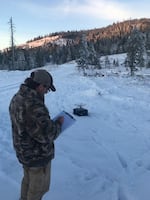
Deep in the forests of northeastern Washington, snow blankets the ground. Through the trees, it’s hard to see the moose wandering in the woods.
But from a bird’s eye view? You can see a little brown splotch — with antlers.
Wildlife researchers are ditching the usual (costly, time consuming and invasive) ways they count moose. They’re taking to the sky and taking a new drone for a spin.
“Every time we step into the woods, we’re invading wild animals’ habitat. But we should always be trying to minimize our disturbance, and I think that drones are a much less invasive method (to survey moose) than some of the things that we currently do,” said James Goerz, lead researcher for the moose demography project in Washington and Ph.D. student at the University of Montana.

Lead researcher James Goerz checks out the drone before it takes off to photograph moose cows and calves.
Courtesy of Washington Department of Fish and Wildlife
Before this technology, researchers had to trek through dense forests to count moose -- or fly in helicopters.
Hiking in and trying to get a glimpse of a mother moose and her calf is challenging. It’s also stressful to the animals. Wolves and other predators chase them on the ground.
“When we walk in on a moose, and it hears us coming, it’s gone. It’s in the next valley,” Goerz said. “It’ll move hundreds of meters away, if not farther, to get away from us.”
The researchers found drones — that sound like a swarm of bees — don’t scare the moose.
Moose in the northeastern part of the state are doing relatively well, although there is evidence their numbers are starting to decline.
Researchers knew the population wouldn’t grow forever. In fact, moose in almost every other state aren’t doing well. That’s why they wanted to get a look at population trends (things like birth rates and survival numbers) while the state’s moose were still looking pretty good.
In Washington, moose face several challenges.
“With wolves on the landscape, obviously wolves kill and eat moose,” said Rich Harris, who manages the Washington Department of Fish and Wildlife’s research on moose.
Harris said moose do really well right after wildfires, in areas that have new shrubs. But dense forests can’t support large herds. Then there are ticks, which spread diseases and do well in mild winters. They’re predicted to get worse as the climate warms.
If researchers know what’s going on with moose populations now, they can better understand what’s happening when these challenges start to hit Washington’s moose harder.
Harris said it’s important that hobbyists don’t try to take drones to the sky above moose or other wildlife. People could end up harassing wildlife with a drone, which is illegal in Washington.
The drone work is promising, Harris said. But the state doesn’t have immediate plans for more drone test projects. (They were able to get a licensed drone pilot to help out with this experiment.)
Drones have a few limitations right now, especially with some of the Federal Aviation Administration guidelines in place. The drone has to stay in sight of the operators and can only fly 400 feet above the ground, making it more of a “giant extendo-arm,” Harris said, than a long-range surveyor.
“I would love to see us be able to use them for the kinds of survey flights that we typically do with helicopters now,” Harris said. “I don’t anticipate that happening for a few years at least. … We can only go at the speed that state and federal regulatory bodies permit us to go.”
But using drones instead of helicopters could be safer for people, less expensive for the agency, and could create less stress for wildlife below, Harris said.
From the sky this month, the researchers saw a radio-collared female moose with her baby moving across the hillside. Later, the drone allowed them to spot five bulls; with their eyes the researchers only saw one.
“It just goes to show that we don’t see everything,” Goerz said. “When we think we know what’s going on, we only have a ground perspective. Once we put that drone into the air, we realized we weren’t seeing everything.”
